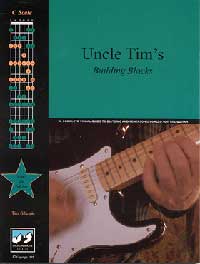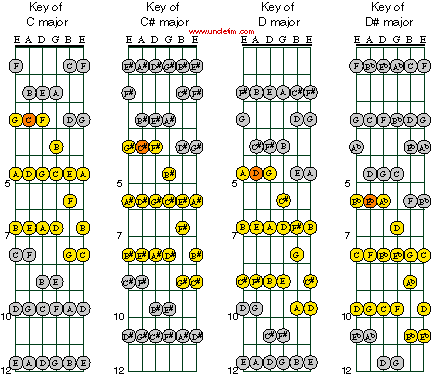

Learn how to solo once and for all!
Soloing is like learning to talk. Knowing the words in not enough. You have to be able to form phrases in the key and then transform them into statements. There is no time to read music notation or learn where the notes are when forming a solo. You have to show up with this information already in place. Building Blocks will show you this using images because once you have the image in your head, you know exactly where to go and you can do it on the spot.
There is nothing like it and nothing can make up for it. For $20, you can put this all to rest right now. Pick up a copy today.
eBooks are delivered instantly!
By Tim Gillespie
Maybe this column should be called "The Need For Comfort" since the first thing you want to do is get comfortable with the Diatonic Signature. Getting comfortable means becoming familiar with it so you can start to use it. One of the first ways to get comfortable is to find the fragments you already know. Once you lock them in place, you start to feel comfortable exploring other concepts.
Here is an example. Most people know a few fragments. The first thing you can do is look inside the signature to see if you can identify it.
 This is a scale fragment in the key of C. Notice this run
starts on the C note on the A string and extends up to the A note in the
high E string. This is a very common pattern to see someone play. I remember
one specific conversation I had with a music store owner who thought this
was the entire scale of C. This was the only place he had ever played
a C scale and he thought it was the only place you could play one. It
only took a few minutes and that thought was forever wiped out of his
mind.
This is a scale fragment in the key of C. Notice this run
starts on the C note on the A string and extends up to the A note in the
high E string. This is a very common pattern to see someone play. I remember
one specific conversation I had with a music store owner who thought this
was the entire scale of C. This was the only place he had ever played
a C scale and he thought it was the only place you could play one. It
only took a few minutes and that thought was forever wiped out of his
mind.
The fragment can be extended by adding other notes found in the key of C. The next diagram shows a typical way to extend this fragment to include three more notes lower in the next octave.
 All
we are doing here is adding a few more notes so we can travel farther
down the scale and use the available notes. At this point you might think
this is as low as you can go. There are three notes below this G note.
The low E open string is the lowest note available on a standard tuned
guitar. As far as pathways go, there is another pathway right below this
one.
All
we are doing here is adding a few more notes so we can travel farther
down the scale and use the available notes. At this point you might think
this is as low as you can go. There are three notes below this G note.
The low E open string is the lowest note available on a standard tuned
guitar. As far as pathways go, there is another pathway right below this
one.
 Look at the fragment to the right. This is the standard
open string beginner scale for the key of C. Do not be fooled by the beginner
label. This is a very useful scale. Many times I use this scale after
I have been constructing a solo higher up the fretboard. The contrast
from playing up high and then working to the open string scale and taking
advantage of the sound of open strings can be quite a nice change. Open
string scales are very important and should be memorized for all keys.
If you do that you are automatically memorizing the twelve fret pattern.
Uncle Tim's First Year teaches all the open string scales. The final two
pages show the reader that if you know the open string scales you already
know the twelve fret pattern. Then we stack the open string patterns to
actually construct the diatonic signature.
Look at the fragment to the right. This is the standard
open string beginner scale for the key of C. Do not be fooled by the beginner
label. This is a very useful scale. Many times I use this scale after
I have been constructing a solo higher up the fretboard. The contrast
from playing up high and then working to the open string scale and taking
advantage of the sound of open strings can be quite a nice change. Open
string scales are very important and should be memorized for all keys.
If you do that you are automatically memorizing the twelve fret pattern.
Uncle Tim's First Year teaches all the open string scales. The final two
pages show the reader that if you know the open string scales you already
know the twelve fret pattern. Then we stack the open string patterns to
actually construct the diatonic signature.
If you need to go through the actual playing of notes for these scales, go back and take a look at the animated gifs in previous editions to make sure you are familiar with playing them. Once again let me say it is one thing to look and notice, it is another thing to play this.
So start by pulling out the fragments you already know, believe me if you know any, they are in this pattern.
The next exercise I would try is to pick a scale fragment and run it for the entire fretboard. To illustrate this concept we will use the examples in "The Playground".
 Notice
this exercise is based on one scale fragment (the yellow notes). This
is a very important pathway and one that is used extensively. This fragment
allows for travel to almost any area of the fretboard. You can start high
and work low. You can start out on the left and work to the right. It
covers a lot of ground and can often set things up for the next move.
This is a very useful pathway.
Notice
this exercise is based on one scale fragment (the yellow notes). This
is a very important pathway and one that is used extensively. This fragment
allows for travel to almost any area of the fretboard. You can start high
and work low. You can start out on the left and work to the right. It
covers a lot of ground and can often set things up for the next move.
This is a very useful pathway.
For this exercise play this scale starting on the orange note which is also tonic for each fragment.
I would start low and work up the fretboard and then back down. Play all the yellow dots. After you play this a while, try to play it in the other keys. For instance if you move it one fret closer to the nut from the C scale, you will be playing a B major scale. If you move it back three frets from the C position you will be working with the open A major scale. The tonic note would move from C to A (on the A string). Each time you play the scale move the whole pattern up one fret. Keep doing this until you go so high up the fretboard you have trouble hitting all the notes. On an acoustic (non-cutaway), this will happen somewhere between the twelfth and fifteenth frets.
With past issues you can pull out most of the patterns in the signature. Then you will internalize this information and start to take ownership. If you keep playing with this, it will soon find it's way into your daily playing. All you have to do is work though the exercises and think a little. The rest will fall into place.
Can you develop speed from these exercises? Certainly, but first you must be able to play it with no mistakes. Only then will the speed element naturally fall into place. You never want to rush speed, it will show up when it is time.
You may expect many more discussions about this signature. Like I said it contains 100% of diatonic keys inside it. In a very real sense this signature unifies everything diatonic.